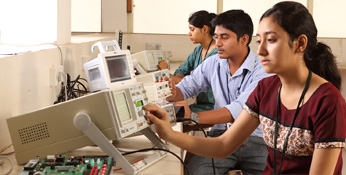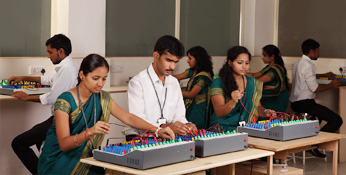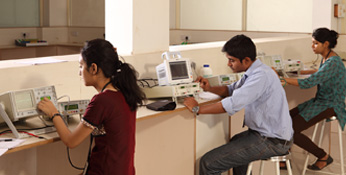Rajiv Gandhi Institute of Technology
Bio-Medical Engineering
Biomedical engineering, also known as bioengineering, is the application of engineering principles to the study of medical and biological problems. The goal of biomedical engineering is to use electrical,chemical, and mechanical engineering principles to conduct studies and develop tools that can aid in the biomedical care of patients. In 1997, the National Institute of Health issued the following expansive defenititon of biomedical engineering/bioengineering."Bioengineering integrates physical,chemical,or mathematical science and engineering principles for the study of biology,medicine,behavior,or health.It advancesfundamental concepts, creates knowledge from the molecularto the organ system levels,and develop innovative biologic naterial impalnts,devices and informatic approaches for the prevention diagnosis,and treatment of disease,for patient rehabilitation,and for improving health."
DESCRIPTION
Biomedical engineering can trace its history to as far back as a hundred years ago, when the first x-ray machines and electrocardiographs dramatically illustrated how technology could be applied towards the diagnosis of disease. Today, the field of biomedical engineering is in full flower, propelled by the momentum of the post-World War II technology boom and the latest molecular, genetic, and computational developments. Having gone beyond its roots in imaging and instrumentation, biomedical engineering now emcompasses at least 13 specialities, according to the 2000 edition of The Biomedical Engineering Handbook.
DISCIPLINES IN BIO-MEDICAL ENGINEERING
The AbioCor artificial heart, an example of biomedical engineering application of mechanical engineering with biocompatible materials for Cardiothoracic Surgery using an artificial organ.
Biomedical instrumentation amplifier schematic used in monitoring low voltage biological signals, an example of a biomedical engineering application of electronic engineering to electrophysiology.
Breast implants, an example of a biomedical engineering application of biocompatible materials to cosmetic surgery.
Schematic representation of normal ECG trace showing sinus rhythm, an example of a biomedical engineering application of electronic engineering to electrophysiology and medical diagnosis.
A pump for continuous subcutaneous insulin infusion, an example of bio-medical engineering application of electrical engineering to medical equipment.
An MRI scan of a human head, an example of a bio-medical engineering application of electrical engineering to diagnostic imaging.
Artificial limbs: The right arm is an example of a prosthesis, and the left arm is an example of myoelectric control.
Implants, such as artificial hip joints, are generally extensively regulated due to the invasive nature of such devices.
A prosthetic eye, an example of a biomedical engineering application of mechanical engineering and biocompatible materials to opthalmology.
EDUCATION AND TRAINING
A four-year university degree in a biomedical engineering or bioengineering program is the minimum required for a biomedical engineer. The undergraduate program gives training in both biological and engineering aspects of the field, and specialization ina subfield may be required. The undergraduate degree program is accredited by AICTE, which imposes strict requirements on curriculum design and quality.
Students who enjoy math, physics and chemistry, but who also have a keen interest in biology and medicine, should consider a career in biomedical engineering. Synthetic heart valves, the MRI scanner, and automatic bio-sensors for rapid gene sequencing are each examples of biomedical engineering. Biomedical Engineering (BME) is the newest engineering discipline, integrating the basic principles of biology with the tools of engineering.
With the rapid advances in biomedical research, and the severe economic pressures to reduce the cost of health care, biomedical engineering plays an important role in the medical environment of the 21 st century. Over the last decade, biomedical engineering has evolved into a separate discipline bringing the quantitative concepts of design and optimization to problem in biomedicine.
The opportunities for biomedical engineers are wide ranging. The medical-device and pharmaceutical industries are increasingly investing in biomedical engineers. As gene therapies become more sophisticated, biomedical engineers will have a key role in bringing these ideas into real clinical practice. Finally, as technology plays an ever increasing role in medicine, there will be a larger need for physicians with a solid engineering background. From biotechnology to tissue engineering , from medical imaging to microelectronic prosthesis, from biopolymers to rehabilitation engineering, biomedical engineers are in demand.
The occupational outlook for biomedical engineering is good, particularly for those engineers who elect to work in industry. According to the University of Cincinnati Center for Economic Education, the medical instruments and supplies industry grew by 27% during the period from 1987 to 1994. The biotechnology industry has been expanding at an even faster rate. Although the recent economic downturn has slowed the expansion in the biotechnology sector somewhat, the health care industry and allied industries are expected to maintain strong growth.
The American Society for Engineering Education reports that, among biomedical engineering Ph.D. graduates who received their degrees during the academic year 1996-97, the average starting salary for those working in industry was $62,000. About 50% of Ph.D. biomedical engineering graduates surveyed chose to work at universities, and the average salary of this group of graduates was $48,000. The average salary of clinical engineers(who do not have PhDs) was also $48,000.
For biomedical engineering technologists, particularly those who work at hospitals, the outlook is very bright. According to the Association for the Advancement of Medical Instrumentations, the high demand for and relative shortage of BMETs mean higher salaries and greater benefits for job candidates. According to the 2000 salary survey reported in the Journal of Clinical Engineering, the average salary for a BMETI position in 1999 was $31,600, while that of a BMET III position was $48,000.
Overall, the occupational outlook for biomedical engineers and biomedical engineering technologists is very good, especially in hospitals and private industry. Because of the continuing interest in biomedical technology developments, demand for biomedical engineers in government and at research institutes will remain moderately strong.
Employment Situation after Graduation
Placement in working life after graduation
Nine out of ten have a placement within three months of their graduation
Placement in working life after graduation(n=203)
JOB FINDERS
As the healthcare field continue its rapid growth and the role of technology in diagnostic, therapeutic and research activities continue to expand, skilled biomedical engineers will be in demand. In fact, the biomedical engineering cereer field is increasing at about 26% per year through 2021 according to the U.S. Department of Labor. That's double the rate for all other jobs combined!.
Combining traditional engineering expertise with an understanding of biological processes, biomedical engeneering technology degree holders work with physicians, therapists and other technicians in the design, construction.










